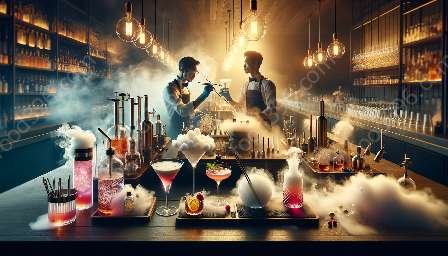Understanding Texturizing Agents
Molecular mixology is an innovative approach to cocktail making that involves the use of scientific techniques and ingredients to create unique and visually stunning beverages. Central to this approach are texturizing agents, which play a critical role in creating liquid spheres, compatible with foam and spherification techniques.
Texturizing Agents and Molecular Mixology
Texturizing agents are substances that modify the texture of a liquid, allowing for the creation of unique shapes and forms. In the context of molecular mixology, these agents are used to produce liquid spheres, which add both visual appeal and a burst of flavor to cocktails. Some of the key texturizing agents used in molecular mixology include agar agar and calcium chloride.
Agar Agar
Agar agar, derived from seaweed, is a natural gelling agent that is commonly used in molecular mixology to create liquid spheres. When agar agar is combined with a flavorful liquid, such as fruit juice or cocktail ingredients, and then exposed to cold temperatures, it forms a gel that encapsulates the liquid, resulting in a delicate and visually striking sphere that adds a delightful surprise to the cocktail experience.
Calcium Chloride
Calcium chloride is another essential texturizing agent in molecular mixology, particularly when it comes to spherification techniques. When calcium chloride is combined with sodium alginate, a process known as reverse spherification can be achieved. The result is a liquid sphere with a thin membrane that bursts in the mouth, releasing a burst of flavor that enhances the overall drinking experience. Additionally, calcium chloride is also used to create foams in molecular mixology, providing a unique textural element to cocktails.
Compatibility with Foam and Spherification Techniques
The use of texturizing agents for creating liquid spheres aligns seamlessly with foam and spherification techniques, both of which are fundamental to the molecular mixology process. Foams are created using culinary foam siphons or nitrous oxide chargers, with ingredients such as egg whites, gelatin, or agar agar, allowing mixologists to incorporate unique textures and flavors into their cocktails. Similarly, spherification techniques, which involve the transformation of liquids into delicate spheres, are enhanced by the use of texturizing agents like agar agar and calcium chloride.
Enhancing Molecular Mixology with Texturizing Agents
Texturizing agents not only serve to enhance the visual appeal of cocktails by creating alluring liquid spheres, but they also contribute to the overall sensory experience. By adding an element of surprise and interactivity to the drink, these liquid spheres engage and captivate the consumer, resulting in a memorable and immersive drinking experience.
Conclusion
Texturizing agents are indispensable in the realm of molecular mixology, allowing mixologists to push the boundaries of creativity by introducing visually stunning and flavorful liquid spheres. Through the use of texturizing agents such as agar agar and calcium chloride, the compatibility with foam and spherification techniques, and the application of molecular mixology principles, the world of cocktail creation is expanded, offering a new dimension of excitement and innovation for both mixologists and consumers alike.

